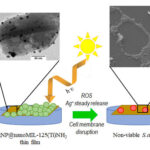Tag Archives:biofilm
Antifouling photo-bactericidal combined effect of a Ag@nanoMOF
Wicherhamomyces anomalus biofilm supported on wood husk for chromium wastewater treatment
High potential polymer carriers to enhance antibiotic efficiency in bacterial biofilms
Nanotechnology, is it something useful for future agriculture?
Host factors, the “Simon Says” for microbial biofilms
Microfluidic “plaque-on-a-chip” with pH new imaging concept probes individual factors in tooth decay
Materials for tomorrow: right next to us!
Potassium in dental plaque, an old story with a new perspective
耀斑和结果:不同的旋转动作ning bacteria
Protecting titanium implants from infection
Certain microorganisms are capable of growing in layers, forming biofilms on medical surfaces, like implants, heart valves, etc… Biofilm-associated infections on implants are responsible for 15-25 % of implant failures as biofilms are resistant to most of the





















